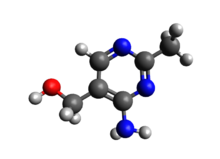Chemistry:4-Amino-5-hydroxymethyl-2-methylpyrimidine

| |

| |
| Names | |
|---|---|
| Preferred IUPAC name
(4-Amino-2-methylpyrimidin-5-yl)methanol | |
| Other names
HMP
| |
| Identifiers | |
3D model (JSmol)
|
|
| ChEBI |
|
| ChemSpider | |
| KEGG | |
PubChem CID
|
|
| UNII |
|
| |
| |
Except where otherwise noted, data are given for materials in their standard state (at 25 °C [77 °F], 100 kPa). | |
| Infobox references | |
Within the field of biochemistry, 4-amino-5-hydroxymethyl-2-methylpyrimidine (HMP) also known as toxopyrimidine together with its mono phosphate (HMP-P) and pyrophosphate (HMP-PP) esters are biogenetic precursors to the important biochemical cofactor thiamine pyrophosphate (TPP), a derivative of thiamine (vitamin B1).
HMP, HMP-P and HMP-PP are found along with thiamine forms in a wide variety of living organisms. Thiamine in various salt, formulation and biological matrix forms are used to supplement human and animal diets because these organisms lack the capability to produce it. Methodologies are being sought for biotechnology-based production of thiamine forms and for increasing thiamine content in food sources.
TPP biogenesis
In microorganisms and plants TPP results from coupling of pyrimidine fragment HMP-PP with thiazole fragment HET-P to give thiamine monophosphate, followed by conversion to the pyrophosphate.[1][2]
Biogenesis of HMP-P and HET-P vary with types of organism.
HMP-P biogenesis
In bacteria, HMP-P arises by conversion of the purine biosynthetic precursor 5-aminoimidazole ribotide (AIR) through the action of enzymes such as phosphomethylpyrimidine synthase, a member of the radical SAM superfamily.[3][4] Studies using isotopically labelled AIR have shown which atoms carry into the product.[5][6] Mechanisms by which this occurs are not yet known with certainty.
In yeasts, HMP-P is derived from metabolites of histidine and pyridoxine.[7][8] Some of these transformations appear to be catalyzed by radical SAM enzymes. Isotopically labelled precursors have been used to investigate this biogenesis.[5][9][10] Mechanisms of the transformations are unknown.
In Salmonella, HMP-P can be derived independently of purine biogenesis when AICAR is available.[11][12]
In algae, thiamine forms and precursors are scavenged by uptake from water of exogenous products from other organisms. In higher plants, thiamine biogenesis resembles that of bacteria.[2][13] In some circumstances, thiamine forms and precursors may be obtained through symbiotic relationships with microorganisms in the soil.
Genes relevant for transformations in the biogenesis of HMP-P, HET-P, and TPP have been identified in various organisms and some of the proteins resulting from their expression have been characterized.[14][15] Biosynthesis of TPP is feedback inhibited through actions of a riboswitch.[16]
Research is ongoing towards understanding biochemistry involved and towards facilitating technologies of socioeconomic value for supply of thiamine in various forms.
Related technologies
Commercially available salts thiamine chloride and thiamine nitrate are produced at scales of thousands of tons annually by chemistry-based manufacturing processes in Europe and Asia.[17][18] These salts are supplied for formulations for supplementation of human diet and as feed additives for cattle, swine, poultry and fish.
Research for potential biotechnology-based production of thiamine[19][20][21] has resulted in patent applications claiming fermentation using recombinant microorganisms modified to deregulate feedback inhibition and allow release of thiamine forms to the media as demonstrated at small scale.[22][23]
Thiamine forms and their bio-precursors are produced at very large scale in biological matrices such as yeast, grains, plants and meats widely consumed as food and feed. Research into genetic modification of plants.[24] has led to higher levels of thiamine in foodstuffs, such as rice.[25] Use of thiamine forms and their bio-precursors by various means such as seed coating or soil and foliar fertilization to improve plant growth and properties are being investigated.[26]
References
- ↑ "The structural and biochemical foundations of thiamin biosynthesis". Annual Review of Biochemistry 78 (1): 569–603. 2009. doi:10.1146/annurev.biochem.78.072407.102340. PMID 19348578.
- ↑ 2.0 2.1 "Vitamin B biosynthesis in plants". Phytochemistry 68 (14): 1904–21. July 2007. doi:10.1016/j.phytochem.2007.03.038. PMID 17512961.
- ↑ "Radical S-adenosylmethionine enzymes". Chemical Reviews 114 (8): 4229–317. April 2014. doi:10.1021/cr4004709. PMID 24476342.
- ↑ "Reconstitution of ThiC in thiamine pyrimidine biosynthesis expands the radical SAM superfamily". Nature Chemical Biology 4 (12): 758–65. December 2008. doi:10.1038/nchembio.121. PMID 18953358.
- ↑ 5.0 5.1 "Biosynthesis of vitamin B1 (thiamin): an instance of biochemical diversity.". Angewandte Chemie International Edition in English 36 (10): 1032–46. May 1997. doi:10.1002/anie.199710321.
- ↑ "Cofactor biosynthesis--still yielding fascinating new biological chemistry". Current Opinion in Chemical Biology 12 (2): 118–25. April 2008. doi:10.1016/j.cbpa.2008.02.006. PMID 18314013.
- ↑ "Biosynthesis of vitamin B1 in yeast. Derivation of the pyrimidine unit from pyridoxine and histidine. Intermediacy of urocanic acid". Journal of the American Chemical Society 125 (43): 13094–105. October 2003. doi:10.1021/ja030261j. PMID 14570482.
- ↑ "Thiamin pyrimidine biosynthesis in Candida albicans : a remarkable reaction between histidine and pyridoxal phosphate". Journal of the American Chemical Society 134 (22): 9157–9. June 2012. doi:10.1021/ja302474a. PMID 22568620.
- ↑ "Biosynthesis of the thiamin pyrimidine: the reconstitution of a remarkable rearrangement reaction". Organic & Biomolecular Chemistry 2 (17): 2538–46. September 2004. doi:10.1039/B405429F. PMID 15326535.
- ↑ "Comparative biogenetic anatomy of vitamin B1: a 13C NMR investigation of the biosynthesis of thiamin in Escherichia coli and in Saccharomyces cerevisiae". Journal of the American Chemical Society 120 (15): 3581–9. April 1998. doi:10.1021/ja973835r.
- ↑ "Plasticity in the purine-thiamine metabolic network of Salmonella". Genetics 187 (2): 623–31. February 2011. doi:10.1534/genetics.110.124362. PMID 21135073.
- ↑ "Aminoimidazole Carboxamide Ribotide Exerts Opposing Effects on Thiamine Synthesis in Salmonella enterica". Journal of Bacteriology 197 (17): 2821–30. September 2015. doi:10.1128/JB.00282-15. PMID 26100042.
- ↑ "Thiamine in plants: aspects of its metabolism and functions". Phytochemistry 71 (14–15): 1615–24. October 2010. doi:10.1016/j.phytochem.2010.06.022. PMID 20655074.
- ↑ "Biosynthesis of Thiamin Pyrophosphate". EcoSal Plus 3 (2). August 2009. doi:10.1128/ecosalplus.3.6.3.7. PMID 26443755.
- ↑ "Structural biology of enzymes of the thiamin biosynthesis pathway". Current Opinion in Structural Biology 13 (6): 739–47. December 2003. doi:10.1016/j.sbi.2003.10.006. PMID 14675553.
- ↑ "Switching the light on plant riboswitches" (in English). Trends in Plant Science 13 (10): 526–33. October 2008. doi:10.1016/j.tplants.2008.07.004. PMID 18778966.
- ↑ "One hundred years of vitamins-a success story of the natural sciences". Angewandte Chemie 51 (52): 12960–90. December 2012. doi:10.1002/anie.201205886. PMID 23208776.
- ↑ Burdick, David (2000). "Thiamine (B1)". Kirk-Othmer Encyclopedia of Chemical Technology. American Cancer Society. doi:10.1002/0471238961.2008090102211804.a01. ISBN 9780471238966.
- ↑ "Microbial biotechnology for the synthesis of (pro)vitamins, biopigments and antioxidants: challenges and opportunities". Microbial Biotechnology 9 (5): 564–7. September 2016. doi:10.1111/1751-7915.12379. PMID 27373767.
- ↑ "Redesigning thiamin synthesis: Prospects and potential payoffs". Plant Science 273: 92–99. August 2018. doi:10.1016/j.plantsci.2018.01.019. PMID 29907313.
- ↑ "Microbial cell factories for the sustainable manufacturing of B vitamins". Current Opinion in Biotechnology 56: 18–29. August 2018. doi:10.1016/j.copbio.2018.07.006. PMID 30138794.
- ↑ Gronenberg L, Ferla M, Genee M, "A Genetically Modified Bacterial Cell Factory for Thiamine Production", WO patent application 2017103221, published 22 June 2017, assigned to Biosyntia APS
- ↑ Goese M, Perkins J, Schyns G, "Thiamin production by fermentation", US patent application 2009233296, published 17 September 2009, assigned to DSM IP Assets B.V.
- ↑ "Thiamin biofortification of crops". Current Opinion in Biotechnology 44: 1–7. April 2017. doi:10.1016/j.copbio.2016.09.005. PMID 27750185.
- ↑ "Overexpression of Thiamin Biosynthesis Genes in Rice Increases Leaf and Unpolished Grain Thiamin Content But Not Resistance to Xanthomonas oryzae pv. oryzae" (in English). Frontiers in Plant Science 7: 616. 2016. doi:10.3389/fpls.2016.00616. PMID 27242822.
- ↑ "Vitamin B1 functions as an activator of plant disease resistance". Plant Physiology 138 (3): 1505–15. July 2005. doi:10.1104/pp.104.058693. PMID 15980201.
 |

